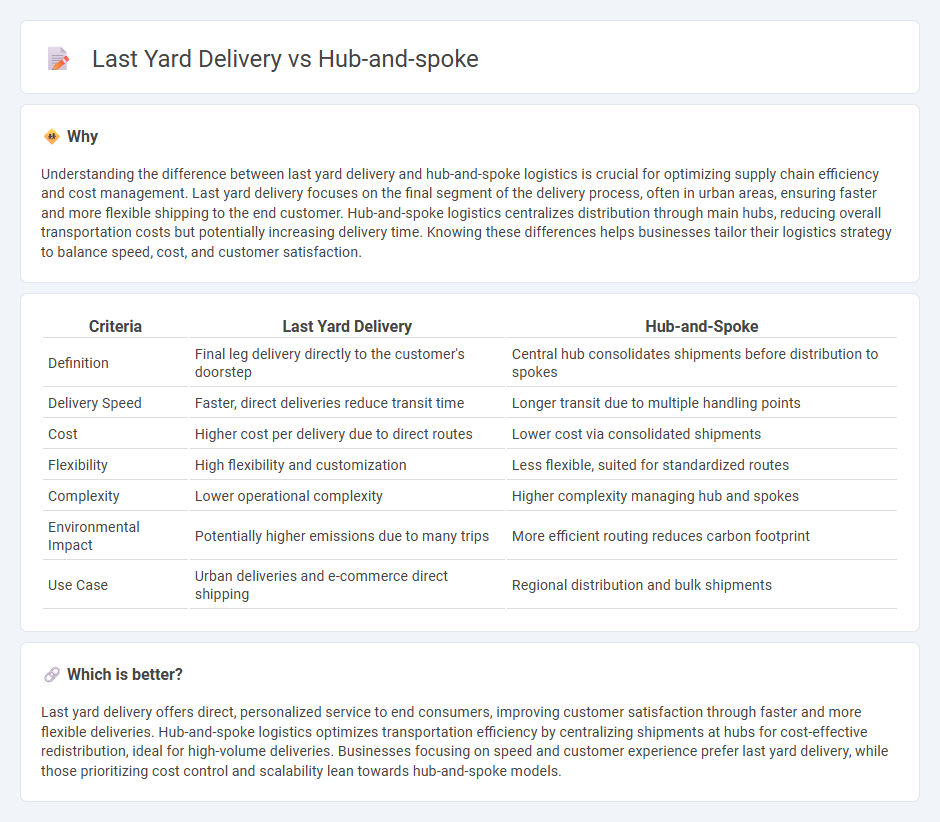
Last yard delivery focuses on transporting goods directly to the final destination, optimizing speed and customer satisfaction in urban areas, while the hub-and-spoke model centralizes distribution through a primary hub before dispatching to multiple spokes or delivery points, enhancing efficiency for large-scale networks. Choosing between these logistics strategies depends on factors like delivery volume, geographic coverage, and service level requirements. Explore more to understand which model best fits your supply chain needs.
Why it is important
Understanding the difference between last yard delivery and hub-and-spoke logistics is crucial for optimizing supply chain efficiency and cost management. Last yard delivery focuses on the final segment of the delivery process, often in urban areas, ensuring faster and more flexible shipping to the end customer. Hub-and-spoke logistics centralizes distribution through main hubs, reducing overall transportation costs but potentially increasing delivery time. Knowing these differences helps businesses tailor their logistics strategy to balance speed, cost, and customer satisfaction.
Comparison Table
| Criteria | Last Yard Delivery | Hub-and-Spoke |
|---|---|---|
| Definition | Final leg delivery directly to the customer's doorstep | Central hub consolidates shipments before distribution to spokes |
| Delivery Speed | Faster, direct deliveries reduce transit time | Longer transit due to multiple handling points |
| Cost | Higher cost per delivery due to direct routes | Lower cost via consolidated shipments |
| Flexibility | High flexibility and customization | Less flexible, suited for standardized routes |
| Complexity | Lower operational complexity | Higher complexity managing hub and spokes |
| Environmental Impact | Potentially higher emissions due to many trips | More efficient routing reduces carbon footprint |
| Use Case | Urban deliveries and e-commerce direct shipping | Regional distribution and bulk shipments |
Which is better?
Last yard delivery offers direct, personalized service to end consumers, improving customer satisfaction through faster and more flexible deliveries. Hub-and-spoke logistics optimizes transportation efficiency by centralizing shipments at hubs for cost-effective redistribution, ideal for high-volume deliveries. Businesses focusing on speed and customer experience prefer last yard delivery, while those prioritizing cost control and scalability lean towards hub-and-spoke models.
Connection
Last yard delivery optimizes the final stage of logistics by ensuring efficient transportation from local hubs to end customers, seamlessly integrating with the hub-and-spoke model where goods are consolidated at central hubs before distribution. This connection reduces transit times and costs, leveraging centralized sorting and route planning to enhance delivery speed and reliability. Implementing last yard delivery in hub-and-spoke networks improves overall supply chain performance by addressing urban congestion and increasing delivery precision.
Key Terms
Centralized Distribution
Centralized distribution hubs optimize inventory management by consolidating shipments before dispatching them to various spokes, reducing transit times and operational costs. In contrast, last yard delivery focuses on the final leg, ensuring efficient parcel delivery to end customers, often addressing challenges like urban congestion and package security. Explore how leveraging centralized distribution can enhance your supply chain efficiency and customer satisfaction.
Spokes/Outstations
Spokes or outstations in hub-and-spoke delivery serve as intermediate points where goods are sorted and consolidated before the final dispatch, optimizing route efficiency and reducing transit times. Last yard delivery centers on the final leg, emphasizing quick, localized distribution often facilitated by spokes to ensure accurate and timely parcel handovers. Explore how leveraging spokes enhances operational efficiency and customer satisfaction in modern logistics.
Final Mile (Last Yard)
Hub-and-spoke models centralize inventory in large hubs, then distribute goods to spokes closer to delivery points, streamlining logistics but potentially extending last-mile times. Last yard delivery zeroes in on the final leg, emphasizing speed and precision by delivering directly to the customer's doorstep, often leveraging local couriers or innovative urban transport solutions. Explore how mastering the last yard can transform your final mile strategy and enhance customer satisfaction.
Source and External Links
What is a Hub-and-Spoke Network: 9 Tips, Benefits & ... - A hub-and-spoke network is a centralized structure where a central hub coordinates communication and resources with various spokes (partner organizations), simplifying communication and improving efficiency.
Spoke-hub distribution paradigm - The hub-and-spoke system is a transport and network topology model that connects outlying points (spokes) through a central hub, optimizing routes and reducing direct point-to-point connections, widely used in aviation and logistics.
Hub-spoke network topology in Azure - In cloud computing, the hub-spoke topology connects multiple virtual networks (spokes) to a central hub network, facilitating shared services, centralized connectivity, and controlled traffic management.
 dowidth.com
dowidth.com